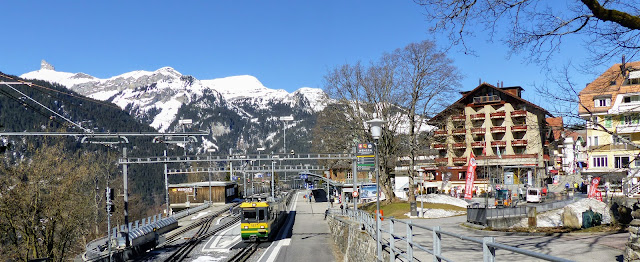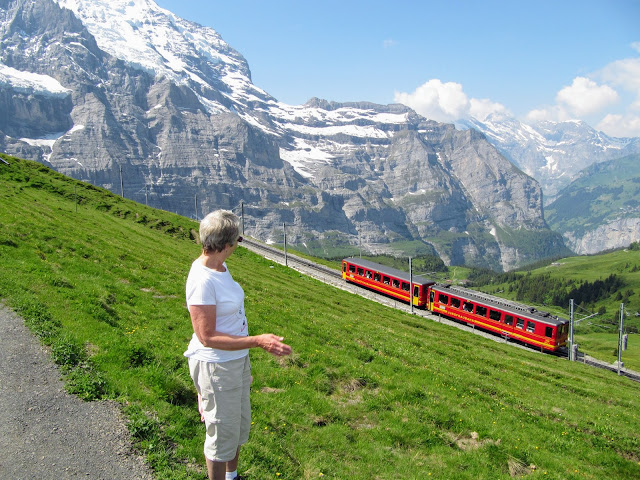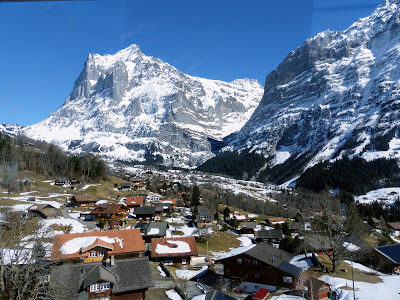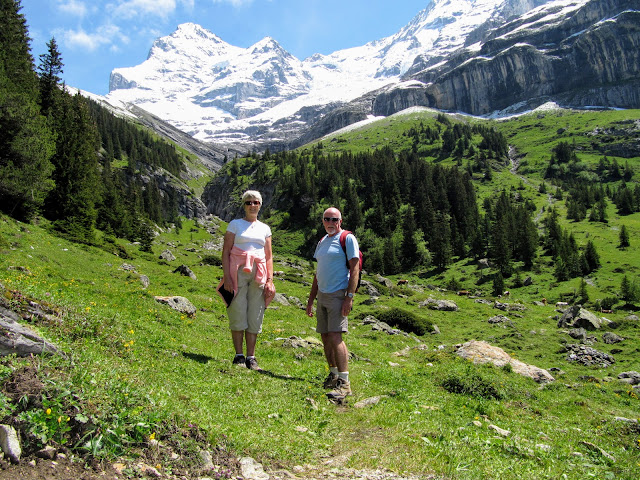We are back in Cornwall after a great week hiking in Switzerland's Jungfrau Region. We have been there a number of times, skiing in winter and hiking in summer, but this was our first time hiking in winter, and ironically it was a lot harder than skiing, which we have given up due to wear and tear!
So beautiful is this region that it has inspired me to write a short travelogue for the benefit of blog readers who might wish to visit this area, a jewel in the Swiss Alps, but a very expensive one- expect to pay roughly twice the price you would pay in UK for drinks, meals etc.
We made full use of our non-ski passes, which gave us unlimited access to the major cable cars and the superb Wengernalp mountain railway, which runs between the villages of Lauterbrunnen and Grindelwald, via Wengen and the Kleine Scheidegg, a mountain pass between the Lauberhorn and the Eiger. This must surely rank as one of the world's greatest short rail journeys, despite the train being 3 seconds late one day!
 |
| Wengen Train Station |
We were based in Wengen, famous for its views of the 4158m Jungfrau, and for the Lauberhorn, the longest of the World Cup downhill skiing events.
 |
| Wengen, with the Jungfrau on the left |
If you are into hiking, then these are our favourites of the many routes available, with photos taken last week and also on our summer visits.
Mannlichen to the Kleine Scheidegg pass
The cable car in the centre of Wengen (1274m) whisked us up to Mannlichen (2343m) and the start of a wonderful 6km hike to the Kleine Scheidegg (2061m), which took us two and a half hours last week in the snow along the well-groomed walking trail. The mountain views are spectacular, and arriving at Kleine Scheidegg, a cold beer at the 19th century Hotel Bellevue des Alpes, at the foot of the north face of the Eiger, was more than welcome.
 |
| Kleine Scheidegg |
 |
| Skiing, 1961 |
From Kleine Scheidegg you can travel by an amazing rail journey through a tunnel cut in the early 1900s through the Eiger and Monch to Jungfraujoch, a saddle at 3466 m connecting the highest peaks in the region, the Monch and the Jungfrau. The railway station is the highest in Europe, and it was at Jungfraujoch that I firsted skied, in 1961, during my school's visit to nearby Interlaken. It would be 29 years before I skied again!
The first station en route from Kleine Scheidegg to Jungfraujoch, Eigergletscher, is the beginning of the famous Eiger trail, open in the summer months, a moderately difficult 6km hike along the base of the north face of the Eiger.
 |
| En route to Eigergletscher, summer 2010 |
 |
| Eiger trail, 2010 |
 |
| Eiger Trail, 2010 |
Although Mannlichen to Kleine Scheidegg is not a long walk, it was quite tough in the snow, and ski poles are recommended in winter. We decided to take the train back to Wengen, rather than the long walk back which we did in the summer of 2010:
 |
| The Wasserstation tunnel, one of the most frightening parts of the World Cup Lauberhorn ski run, where the racers pass under the tunnel at around 100 km/h |
Above Grindelwald
 |
| Grindelwald |
The village of Grindelwald is, at 1034m, the terminus on the train line from Lauterbrunnen. In the summer of 2010 we took the cable car to Pfingstegg, then had a gruelling 2 hour walk to Baregg, with its great views of the rapidly receding Schreckhorn glacier.
Last week we took the long gondola ride to First (2167 m), and then the undulating 6km hike to Lake Bachalpsee, an easy walk in summer, but a bit more demanding in the winter snow, especially in the downhill sections.
There is little evidence of a lake in winter, but in summer this is one of the most photographed lakes in the alps, with its backdrop of the sharp jagged peaks of the Wetterhorn, Schreckhorn and Finsteraarhorn.
From the lake the path leads to the Faulhorn (2681m) and then on to Schynige Platte. Unfortunately the 16km trail from First to Schynige Platte, one of the great alpine hikes, is only open in summer as the cog railway from Schynige Platte down to Wilderswil does not operate in winter.
 |
| By the shore of Lake Bachalpsee |
 |
| Looking down on Lake Brienz from Schynige Platte, 2010 |
Lauterbrunnen and Murren
The cogs on the cog railway really come into play on the steep descent from Wengen to the little village of Lauterbrunnen, but when snow free there is also an easy 1km walk down to the village.
 |
| Walking from Wengen to Lauterbrunnen, 2002 |
The Lauterbrunnen Valley is a geologists dream. Thick beds of Jurassic limestone were deposited as calcareous mud around 140 million years ago, and the Alps began to form about 35 million years ago, when the African tectonic plate forced its way into the more stable tectonic plates of Europe and Asia. These mighty tectonic forces twisted and contorted the rocks, which have been exposed in the steep walls of the valley, which were carved out by glacial action during the last ice age.
 |
| Lauterbrunnen |
The walk through the valley to the Trummelbach falls is an easy 3km in summer and winter. It is a valley of 72 waterfalls, falling from the 450m walls, the most famous being the Trummelbach Falls, which are fed by glacial waterfalls inside the mountain. The Trummelbach drains the glaciers of the Eiger, Monch and Jungfrau mountains and carries 20,200 tonnes of eroded sediment per year. Trummelbach is a series of ten waterfalls inside the mountain made accessible by a tunnel-funicular and stairs, built 1913, which is open only in the summer months.
 |
| Walking in the Lauterbrunnen Valley, 2002 |
Just opposite Lauterbrunnen station is the cable car up to Grutschalp, which is 6.5 km from Murren, either by a regular mountain train, or via an easy walking trail affording spectacular views of the Eiger, Monch and Jungfrau.
 |
| Murren |
The tiny village of Murren is within touching distance of the Jungfrau, but is famous for being at the foot of the Schilthorn (2970m), the location for the 1969 James Bond film On Her Majesty's Secret Service. If you are a Bond fan then you may wish to join the long queues for the two cable cars which take you up to the summit, and Piz Gloria, the revolving restaurant which, during its construction in 1968 was used as the HQ of the evil SPECTRE organisation in the movie.
 |
| Piz Gloria, Schilthorn |
Apart from the spectacular views there is also an exhibition of the making of the movie, and the impact that it had on the small Murren community.
 |
| Panoramic views from the Schilthorn |
Interlaken
The town of Interlaken is the gateway to the Jungfrau region, and it is worth spending a few hours in this town of elegant Victorian hotels, situated between two large lakes, Thun to the west and Brienz in the east. On our final afternoon last Friday, we took the train from Lauterbrunnen to Interlaken Ost, and then strolled along the bank of the River Aare, which separates the two lakes.
And then back to Wengen to enjoy the last view of sunset on the Jungfrau.
In summary, although the winter hiking is good it does not compare with that in summer, where there are more options available, such as walking down wide alpine meadows, many of which are winter ski runs.
So for any MEI Conference delegate wishing to do something special in Europe after, hopefully, spending some time in Cornwall, I would thoroughly recommend June or July in Switzerland's Jungfrau region of the Bernese Oberland.
There are many tour operators who can help you travel to the region. We chose the excellent Inghams. We travelled by train from Falmouth to Bristol (Temple Meads) and flew from Bristol to Geneva, where the Inghams coach transferred us to Lauterbrunnen, and the short train journey to Wengen. Our accommodation in Wengen was at the impressive Beauside Park Hotel, looking down on the village and the backdrop of the Jungfrau. Returning to Bristol, the train to Taunton will take you to the main line back to London.
If this posting persuades you to visit this wonderful German speaking area of Switzerland, please share your experiences via comments on this posting. Enjoy your visit. I'm sure you will.
Twitter @barrywills




























-EDIT.jpg)






Another very good reason to hike in summer: the departures hall at Geneva Airport is a nightmare in the ski season, full of skiers from French and Swiss resorts. We arrived two and a half hours before our flight, which was boarding when we eventually checked in and passed through security. The check-in queue was huge, but never anywhere have I seen a queue so long for security.
ReplyDeleteBarry,
ReplyDeleteBoth of you are amazing couple; Nature and adventure are your motivators to take both of you to these heights in mineral engineering; inspiration to many of the present and definitely of future.
Bless you both.
Rao
Thanks
DeleteThank you for sharing this valuable knowledge.
ReplyDeleteI've read a lot of blogs, but I've never seen anything quite like this. Furthermore, I'm grateful for the opportunity to introduce myself through your posts. All you've written has left me speechless. For an instance, I've bookmarked this for future reference because it's still really useful, even after many years. You have defined clearly about hiking in Switzerland, instruction & adventurous moments that we can enjoy.
Wonderful article, many thanks. My wife and I have been debating where to go to in Switzerland. Now we know!
ReplyDeleteBrian Bailey, Mossley, UK
I’ve just noticed very clear evidence of climate change in two of the photos. Can you spot it?
ReplyDelete